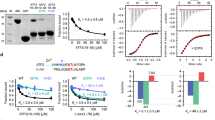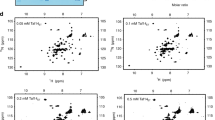Abstract
The ternary complex factors (TCFs), Elk-1, Sap-1a and Net, are key integrators of the transcriptional response to different signalling pathways. Classically, three MAP kinase pathways, involving ERK, JNK, and p38, transduce various extracellular stimuli to the nucleus. Net is a repressor that is converted into an activator by Ras/ERK signalling. Net is also exported from the nucleus in response to stress stimuli transduced through the JNK pathway, leading to relief from repression. Here we show that ERK and p38 bind to the D box and that binding is required for phosphorylation of the adjacent C-terminally located C-domain. The D box as well as the phosphorylation sites in the C-domain (the DC element) are required for transcription activation by Ras. On the other hand, JNK binds to the J box in the middle of the protein, and binding is required for phosphorylation of the adjacent EXport motif. Both the binding and phosphorylation sites (the JEX element) are important for Net export. In conclusion, specific targeting of Net by MAP kinase pathways involves two different docking sites and phosphorylation of two different domains. These two elements, DC and JEX, mediate two distinct functional responses.
This is a preview of subscription content, access via your institution
Access options
Subscribe to this journal
Receive 50 print issues and online access
$259.00 per year
only $5.18 per issue
Buy this article
- Purchase on Springer Link
- Instant access to full article PDF
Prices may be subject to local taxes which are calculated during checkout








Similar content being viewed by others
References
Cahill MA, Janknecht R and Nordheim A. . 1996 Curr. Biol. 6: 16–19.
Chen C and Okayama H. . 1987 Mol. Cell. Biol. 7: 2745–2752.
Criqui-Filipe P, Ducret C, Maira SM and Wasylyk B. . 1999 EMBO J. 18: 3392–3403.
Cruzalegui FH, Cano E and Treisman R. . 1999 Oncogene 18: 7948–7957.
Dai T, Rubie E, Franklin CC, Kraft A, Gillespie DA, Avruch J, Kyriakis JM and Woodgett JR. . 1995 Oncogene 10: 849–855.
Derijard B, Hibi M, Wu IH, Barrett T, Su B, Deng T, Karin M and Davis RJ. . 1994 Cell 76: 1025–1037.
Dickens M, Rogers JS, Cavanagh J, Raitano A, Xia Z, Halpern JR, Greenberg ME, Sawyers CL and Davis RJ. . 1997 Science 277: 693–696.
Ducret C, Maira SM, Dierich A and Wasylyk B. . 1999 Mol. Cell. Biol. 19: 7076–7087.
Giovane A, Pintzas A, Maira SM, Sobieszczuk P and Wasylyk B. . 1994 Genes Dev. 8: 1502–1513.
Gupta S, Barrett T, Whitmarsh AJ, Cavanagh J, Sluss HK, Derijard B and Davis RJ. . 1996 EMBO J. 15: 2760–2770.
Gupta S, Campbell D, Derijard B and Davis RJ. . 1995 Science 267: 389–393.
Han J, Jiang Y, Li Z, Kravchenko VV and Ulevitch RJ. . 1997 Nature 386: 296–299.
Hibi M, Lin A, Smeal T, Minden A and Karin M. . 1993 Genes Dev. 7: 2135–2148.
Hill CS and Treisman R. . 1995 Cell 80: 199–211.
Jacobs D, Glossip D, Xing H, Muslin AJ & Kornfeld K. . 1999 Genes Dev. 13: 163–175.
Janknecht R and Hunter T. . 1997 EMBO J. 16: 1620–1627.
Kaffman A, Herskowitz I, Tjian R and O'Shea EK. . 1994 Science 263: 1153–1156.
Kaffman A, Rank NM, O'Neill EM, Huang LS and O'Shea EK. . 1998 Nature 396: 482–486.
Kallunki T, Deng T, Hibi M and Karin M. . 1996 Cell 87: 929–939.
Kallunki T, Su B, Tsigelny I, Sluss HK, Derijard B, Moore G, Davis R and Karin M. . 1994 Genes Dev. 8: 2996–3007.
Komeilli A and O'Shea EK. . 1999 Science 284: 977–980.
Lai ZC and Rubin GM. . 1992 Cell 70: 609–620.
Lin A, Minden A, Martinetto H, Claret FX, Lange-Carter C, Mercurio F, Johnson GL and Karin M. . 1995 Science, 268: 286–290.
Livingstone C, Patel G and Jones N. . 1995 EMBO J. 14: 1785–1797.
Madhani HD and Fink GR. . 1998 Trends Genet 14: 151–155.
Maira SM, Wurtz JM and Wasylyk B. . 1996 EMBO J. 15: 5849–5865.
O'Neill EM, Kaffman A, Jolly ER and O'Shea EK. . 1996 Science 271: 209–212.
Oshima Y. . 1997 Genes Genet. Syst. 72: 323–334.
Porter CM, Havens MA and Clipstone NA. . 2000 J. Biol. Chem. 275: 3543–3551.
Price MA, Cruzalegui FH and Treisman R. . 1996 EMBO J. 15: 6552–6563.
Price MA, Rogers AE and Treisman R. . 1995 EMBO J. 14: 2589–2601.
Raingeaud J, Whitmarsh AJ, Barrett T, Derijard B and Davis RJ. . 1996 Mol. Cell Biol. 16: 1247–1255.
Rao A, Luo C and Hogan PG. (1997). . Annu. Rev. Immunol. 15: 707–747.
Rebay I and Rubin GM. . 1995 Cell 81: 857–866.
Sharrocks AD, Brown AL, Ling Y and Yates PR. . 1997 Int. J. Biochem. Cell Biol. 29: 1371–1387.
Sluss HK, Barrett T, Derijard B and Davis RJ. . 1994 Mol. Cell Biol. 14: 8376–8384.
Sprague Jr GF. . 1998 Genes Dev. 12: 2817–2820.
Tanoue T, Adachi M, Moriguchi T and Nishida E. . 2000 Nat. Cell Biol. 2: 110–116.
Treisman R. . 1996 Curr. Opin. Cell Biol. 8: 205–215.
Wasylyk B, Hagman J and Gutierrez-Hartmann A. . 1998 Trends Biochem. Sci. 23: 213–216.
Wasylyk C, Imler JL, Perez-Mutul J and Wasylyk B. . 1987 Cell 48: 525–534.
Whitmarsh AJ, Yang SH, Su MS, Sharrocks AD and Davis RJ. . 1997 Mol. Cell. Biol. 17: 2360–2371.
Yang SH, Galanis A and Sharrocks AD. . 1999 Mol. Cell Biol. 19: 4028–4038.
Yang SH, Whitmarsh AJ, Davis RJ and Sharrocks AD. . 1998a EMBO J. 17: 1740–1749.
Yang SH, Yates PR, Whitmarsh AJ, Davis RJ and Sharrocks AD. . 1998b Mol. Cell Biol. 18: 710–720.
Zhu J, Shibasaki F, Price R, Guillemot JC, Yano T, Dotsch V, Wagner G, Ferrara P and McKeon F. . 1998 Cell 93: 851–861.
Acknowledgements
We would like to thank: (a) S Sengupta and P Anglard for critical reading of the manuscript; (b) A Bradford, R Davis, A Guttierez-Hartmann and M Karin for the gifts of recombinants; (c) the IGBMC core facilities for help and support; (d) the MRT and BioAvenir for fellowships for C Ducret and M Maira, respectively; (e) BioAvenir (Rhone-Poulenc now Aventis), the Centre National de la Recherche Scientifique, the Institut National de la Santé et de la Recherche Médicale, the Hópital Universitaire de Strasbourg, the Association pour la Recherche sur le Cancer, the Fondation pour la Recherche Médicale, the Ligue Nationale Française contre le Cancer, the Ligue Régionale (Haut-Rhin) contre le Cancer and the Ligue Régionale (Bas-Rhin) contre le Cancer for financial help.
Author information
Authors and Affiliations
Rights and permissions
About this article
Cite this article
Ducret, C., Maira, SM., Lutz, Y. et al. The ternary complex factor Net contains two distinct elements that mediate different responses to MAP kinase signalling cascades. Oncogene 19, 5063–5072 (2000). https://doi.org/10.1038/sj.onc.1203892
Received:
Revised:
Accepted:
Published:
Issue Date:
DOI: https://doi.org/10.1038/sj.onc.1203892
Keywords
This article is cited by
-
Prognostic signature composed of transcription factors accurately predicts the prognosis of gastric cancer patients
Cancer Cell International (2021)
-
Comparison of MAPK specificity across the ETS transcription factor family identifies a high-affinity ERK interaction required for ERG function in prostate cells
Cell Communication and Signaling (2015)
-
MAP kinases and the control of nuclear events
Oncogene (2007)
-
FEV acts as a transcriptional repressor through its DNA-binding ETS domain and alanine-rich domain
Oncogene (2003)
-
Immediate-early gene induction by the stresses anisomycin and arsenite in human osteosarcoma cells involves MAPK cascade signaling to Elk-1, CREB and SRF
Oncogene (2003)



